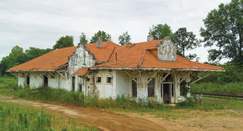
 Railroad Depots of the nineteenth and early twentieth centuries were often designed to make good first impressions. Beyond their strictly utilitarian function, they were also symbols of the places that they served. Constructed in 1907, the depot served the Atlanta, Birmingham and Atlantic Railroad, which was organized in 1905, forming one important part of the new Wadley community. The town was originally planned as a model city that would harness nearby water power as an energy source. However, because it did not attract enough residents, the dream failed to materialize as an economic boom town.
0 Comments
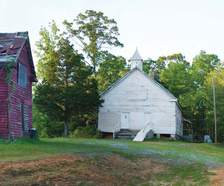 Click image to enlarge. Click image to enlarge. The Mt. Pleasant Baptist Church and Community Day School have served the community of Hamburg for many years. Constructed in 1912, the church was the only African American Baptist congregation in the Wilcox County farming community of Hamburg. For decades the adjacent school, dating from 1915, served the children of the community, many of whom worked the fields before attending classes. Today the church and the school look much as they did when they were built, but needed repair work is now hampered by lack of funds and an aging congregation. Still, members of the church and the community are determined to save these two local landmarks.  Click image to enlarge. Click image to enlarge. Slave cemeteries are significant, yet largely forgotten, historic resources in Alabama. Many cemetery locations are unknown, and those that have been identified are often abandoned, neglected, and in peril. While the location of the Old Prewitt Slave Cemetery near Northport has been known for generations, it is still endangered by nature, logging, isolation, and development pressures (the cemetery is located near prime lakefront property). During the 1820s plantation owner and slave trader John Welch Prewitt established the two-acre burial ground on his six-thousand-acre estate. Possibly the largest slave cemetery in Alabama, the Prewitt site became the burial location for three hundred to five hundred slaves, along with family members of post-emancipation generations. Flat rocks and solid slabs of arched stone, and crudely etched, hand-cut, river-rock markers, are scattered throughout the cemetery, along with numerous unmarked graves. Prewitt family descendants, both black and white, are determined to keep up the cemetery and deal with the forces of man and nature that have damaged many of the markers. 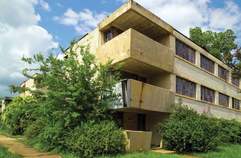 Click image to enlarge. Click image to enlarge. Not too long ago, the Grove Court Apartments in Montgomery may have been overlooked as just another “modern” twentieth-century building. Today, however, preservationists give more attention to identifying and preserving our recent past—those resources dating from the post–World War II era. And, now, buildings such as Grove Court are getting a second look. Designed in 1947 by local architect Clyde Pearson, this building stands out in the capital city as a rare example of the International Style, a contemporary design usually more popular in large urban areas than in smaller cities like Montgomery. Its long rectilinear form, taut plane surfaces devoid of ornamentation, concrete construction, fl at roof, deep cantilevered balconies, corner windows, and bands of metal casement windows are hallmarks of a style rooted in post–World War I Europe. Despite retaining a high level of architectural integrity, the Grove Court Apartments are in a deteriorated condition. The property is currently on the market, and new owners with a renovation plan may provide hope for this landmark of the recent past. Lyric Theatre and Office Building, Birmingham, Jefferson County, 1914 (Places in Peril 2009)10/26/2009 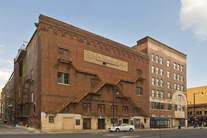 Click image to enlarge. Click image to enlarge. When it was constructed in 1914, the Lyric was the largest theater in Birmingham; today, it is the oldest surviving one in a city once boasting over sixty silent movie houses, theaters, opera houses, and nickelodeons. The biggest names in vaudeville performed here, including Buster Keaton, Sophie Tucker, Will Rogers, Mae West, and the Marx brothers. When it opened, the building displayed classical elements on the exterior, and stunned the audience with an amazing interior, replete with hand-painted murals and other touches of elegance. The theater and adjoining office building (constructed in 1913) were designed by New York architect C. K. Howell and were constructed by Jake Wells of the Wells Amusement Company. |
Alabama's Endangered Historic LandmarksEach year since 1994, Alabama Heritage has highlighted threatened historic sites throughout Alabama. The “Places in Peril” list has identified more than 215 imperiled historic resources throughout the state, and is compiled by the Alabama Historical Commission and the Alabama Trust for Historic Preservation. The locations highlight the results of deferred maintenance, perceived obsolescence, development pressures, and lack of funding—forces that now more than ever threaten our cultural legacy. But awareness is a powerful force, too, and can cultivate a renewed determination to be responsible stewards of our heritage. For more information, visit the AHC or the ATHP websites. Alabama Heritage is proud to bring to you a selection of the places designated as perilous. Please keep your comments to information relevant to the featured place in peril. Alabama Heritage reserves the right to delete any comment that we deem inappropriate. Archives
May 2024
|
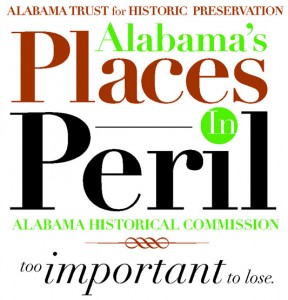
 RSS Feed
RSS Feed